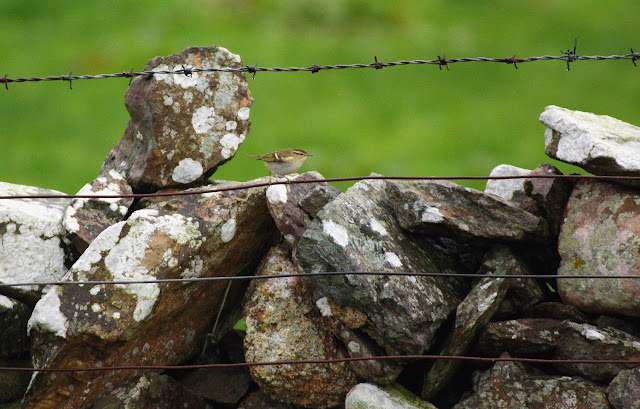On Tuesday, with Mark and Dave, I visited St Abb’s Head for the
Sardinian warbler on my return from Shetland. We had already missed the trip target (thick-billed warbler) and at St Abb’s we added the
skulking Sylvia to the dip list! A takking lesser whitethroat tried
its best to convince us and a yellow-browed remained unseen in a clump
of sycamores. It was my first visit to this site and I remarked as we
waited for our quarry that all would be forgiven if an Eleanora’s
flew over, a bird I could well picture at this setting in October.
Perhaps 25 minutes later a large dark falcon rocketed through the valley.
From the very first glimpse I was convinced from its structure (chunky with fairly short wings) it was nothing more than an exceptionally dark (melanistic) juvenile female peregrine. I fired off some shots in the seconds it was in view and a quick analysis of the photos later failed to change my mind. Yet it was scary and needs highlighting. Surely such birds could be the source of some of our claimed Eleanora’s?
So what of the Shetland trip? Though the original target is now perhaps best forgotten, we did get in a weekend’s birding, the highlights of which came in the form of an Eastern olivaceous warbler at Hoswick and a short-toed lark at Sumburgh. I found a probable Siberian chiffchaff in Lerwick which failed to call and we came across yellow-browed warblers (in 1’s and 2’s) at just about every location we checked. Other highlights included merlin, male redstart, whinchat and common crossbill.
Eastern Ollie, with less than 20 British records, still holds on to its MEGA status and this individual represents my second in the UK and my first for more than 18 years. This bird often showed very well but
unfortunately I had wandered off when it gave prolonged views for 5 minutes or so in the sunshine! I did manage however a view of it sat out in the open for maybe 10 seconds so can’t really complain.
Perhaps 25 minutes later a large dark falcon rocketed through the valley.
From the very first glimpse I was convinced from its structure (chunky with fairly short wings) it was nothing more than an exceptionally dark (melanistic) juvenile female peregrine. I fired off some shots in the seconds it was in view and a quick analysis of the photos later failed to change my mind. Yet it was scary and needs highlighting. Surely such birds could be the source of some of our claimed Eleanora’s?
So what of the Shetland trip? Though the original target is now perhaps best forgotten, we did get in a weekend’s birding, the highlights of which came in the form of an Eastern olivaceous warbler at Hoswick and a short-toed lark at Sumburgh. I found a probable Siberian chiffchaff in Lerwick which failed to call and we came across yellow-browed warblers (in 1’s and 2’s) at just about every location we checked. Other highlights included merlin, male redstart, whinchat and common crossbill.
Eastern Ollie, with less than 20 British records, still holds on to its MEGA status and this individual represents my second in the UK and my first for more than 18 years. This bird often showed very well but
unfortunately I had wandered off when it gave prolonged views for 5 minutes or so in the sunshine! I did manage however a view of it sat out in the open for maybe 10 seconds so can’t really complain.
5.JPG)
2.JPG)
3.JPG)
4.JPG)
.JPG)

,+Virkie.JPG)

,+Grutness.JPG)

Whoa that's a very dark peregrine indeed. If it wasn't exactly peregrine-shaped I'd think it had obsoletus gyr genes in there somewhere and was a lost hybrid. Cracking bird.
ReplyDeleteI did consider the possibility of an escaped hybrid. Some west coast peregrines are v dark but not this much. I thought it was most likely a juv but others have suggested adult...
ReplyDeleteDefinitely juvenile, from that tail :D
ReplyDelete